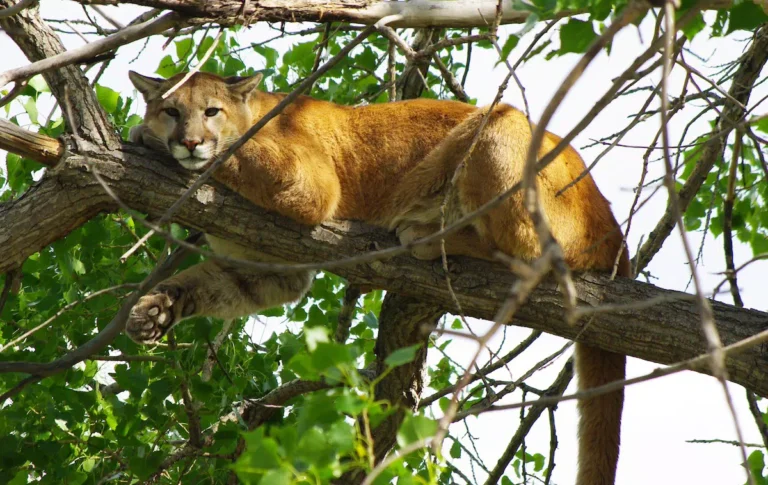Ecological Services
- keeping deer herds healthy from highly infectious, deadly chronic wasting disease
- serving to boost biodiversity and ecosystem health
- reducing vehicle collisions with deer
Colorado Parks and Wildlife's role
Yes. This is exactly what we are asking for and perhaps the most important question of the day.
There is a seismic difference between trophy hunting and trapping wild cats for pleasure and profit, versus professionally managing wildlife that occasionally will come into conflict with people, pets or livestock.
In Colorado, we have a strong multi-agency system with innovative and financial support already in place to deal with these rare situations that Coloradans care about as much as their wildlife. We care about ranchers, and above all, we care about our children and our pets, too.
Program biologists with federal Wildlife Services with its national Wildlife Research Center located in Fort Collins are well funded and use their professional expertise toward preventing and resolving conflicts with and damage from mountain lions in Colorado. About 200 lions receive complaints and 60 are reportedly killed in Colorado each year by Wildlife Services as well as landowners, law enforcement, and Colorado Parks and Wildlife for agricultural control (livestock protection) and other conflicts.
Trophy hunting is its own game and as science clearly shows is not a tool to solve or prevent any conflict. We have professionally trained individuals at the state and federal levels who already are equipped for conflict management work that includes relocating or killing an offending animal.
Stopping trophy hunting and trapping of wild cats won’t affect Colorado’s existing and separate program to help prevent and handle conflicts. So yes, please, we need CPW to do its job.
More specifically, program biologists with federally tax-funded Wildlife Services (USDA) with its national Wildlife Research Center located in Fort Collins use their professional expertise toward preventing and resolving conflicts with and damage from mountain lions in Colorado. About 200 lions are reported as “conflict lions” in Colorado each year and dozens are killed by Wildlife Services as well as landowners, law enforcement, and Colorado Parks and Wildlife for agricultural control (livestock protection) and other conflicts. This has nothing to do with random trophy hunting of mountain lions in Colorado. See data chart below provided by CPW.
USDA on its website says that it resolves wildlife conflicts in Colorado:
“Every day, the Wildlife Services (WS) program in Colorado helps citizens, organizations, industries, and Government agencies resolve conflicts with wildlife to protect agriculture, property, and natural resources, and to safeguard human health and safety. WS’ professional wildlife biologists and specialists implement effective, selective, and responsible strategies that value wildlife, the environment, and the resources being protected. WS manages wildlife damage according to its public trust stewardship responsibilities as a Federal natural resource management program. WS supports the North American Model of Wildlife Conservation, based on the principle that wildlife resources are owned collectively and held in trust by Government for the benefit of present and future generations.”
Producers (ranchers) often turn to Wildlife Services to reduce and prevent further predation. “Wildlife Services’ integrated approach includes recommendations applied by producers and, in many cases, operational wildlife management implemented by Wildlife Services.”
Livestock production is an important industry in Colorado. Losses could be two to three times higher in the absence of (this program’s) livestock protection.
Wildlife Services-Colorado (offices in Lakewood) works cooperatively with the State agriculture and wildlife agencies, counties, and local livestock associations to reduce predation damage for livestock producers.
WS works in partnership with agencies, organizations, and individuals around the nation to protect livestock from predation. Much of WS’ operational management assistance to producers is supported by funds provided by states, counties, producers, and others, in addition to Federally appropriated dollars.
This graf shows about 60 mountain lions are killed in Colorado by state and federal agencies for conflict
No. Trophy hunting and trapping are not conserving anything, but they remain the No. 1 risk to cats’ survivability as an individual or species. Colorado tries not to oversell licenses to kill lions and wipe out the species, so the hunting can continue in this user-pays model of wildlife management. This is not true conservation as most people understand it, because that would put the species ahead of the pleasure of the ticket holder.
While hunting and fishing licenses and fees contribute largely to the wildlife operating budget for our state agency, along with federal dollars and taxes and grants, trophy hunting mountain lions adds a mere 0.14% of a $198 million budget.
If Colorado stopped allowing trophy hunting of our wild cats, that would remove the No.1 risk to their survival individually and as a population statewide. When trophy hunters and those who financially benefit from them link their actions to true conservation of a species, they are being incredibly disrespectful to wildlife and to all Coloradans including fair-chase hunters.
They are not. Trophy hunting mountain lions isn’t a program to manage anything except trophy hunters, so they can have their fun without overkill. Trophy hunting doesn’t make anyone, including pets and kids, safer. It also doesn’t produce more deer or protect livestock and it certainly isn’t helping individual mountain lions and bobcats or their populations. Though, it does have the distinct potential to erase them from the wilds of Colorado.
Trapping unlimited bobcats when we have no statewide data or population count isn’t managing anything, not even trappers.
See our Science Page for the top 10 Science-Backed Reasons Not To Trophy Hunt and Trap Colorado’s Wild Cats.
No, it has been long understood that mountain lion populations are dependent upon prey (deer and elk) and having space to live. If either of these requirements decline, so will mountain lion populations. It is foolhardy to think that trophy hunting is a management tool for populations. It doesn’t work. See our science page for more.
In California, where mountain lions haven’t been hunted for a half-century, and bobcats for 3 years, the populations are stable. In other states where bobcats are not trapped, such as Connecticut and New Jersey overpopulation is not an issue of concern.
We have inherited a 150-year-old wild cat trophy hunting program that is outdated and set up solely to benefit a very small number of trophy hunters and trappers. Change is hard but required if we want to follow the best modern science and do our best job protecting wildlife on a broader ecosystem level, and for benefiting all Coloradans, while serving public safety, and preventing conflict. Once we end mountain lion trophy hunting and trapping of wild cats, CPW will have a tremendous window of opportunity to shift its focus away from random trophy killing that serves no public good, and contribute more positive research on predators as intrinsically valuable alive. As we make room to better understand these predators, and grow our appreciation, this can calm fears and reduce complaints and conflict, and that is a very good direction for Colorado to take.
Watch this 60-second animation showing the vast and broad intrinsic value mountain lions bring to our Colorado wildland ecosystems. Narrator Dr. Mark Elbroch of Panthera highlights research showing 543 distinct interactions between mountain lions with other living species, many are birds of Colorado including migrating bald eagles, Yellow Warblers, Western Tanagers, orioles and so many more. Leading mountain lion ecologists and wildlife conservation scientists hope these studies support more strategic investment in the protection of wild cats for their intrinsic value, alive.
Leading mountain lion ecologists
1
We’re feeling the impacts of climate change and unprecedented biodiversity losses, and looking for ways to build resiliency. One of those ways is investing in apex predators who can do a lot to promote healthy wildlands and habitat for generations.
Today we know that mountain lions hold vast intrinsic and ecological value alive, serving a vital role within our Colorado wildlands ecosystem and are documented to support 500 species through their daily interactions in the forests.
Today, we have the benefit of new independent science from the world’s top lion ecologists, clearly showing that wild cats play a critical role in building and sustaining healthy ecosystems, and notably at a time when biodiversity losses worldwide are at extreme highs due to human activities, including overhunting, pollution, and destruction and fragmentation of habitat.
Watch the 60-second video here showing 543 distinct interactions between mountain lions with other living species. Mountain lion kills leave carrion for multiple species, increasing biodiversity.

2
We also know that mountain lions are highly valuable in Colorado’s fight against the spread of the highly infectious and lethal Chronic Wasting Disease. CWD has been detected in 40 of our 54 deer herds and our wildlife agency says “controlling CWD is “critical for the long-term health of our herds.” A Colorado study shows that mountain lions are much more efficient than humans at lessening both the transmission and prevalence of CWD in our wild places. CWD has also been detected in nearly half of our elk herds and moose. Infectious disease experts warn that CWD could affect people as it mutates and adapts.
CWD is a horrific neurological disease with animals suffering slow deterioration of the brain before death. The fact that mountain lions could be saving thousands of deer, elk and moose from this fate is something all Coloradans – including deer and elk hunters – can appreciate.
“Unlike us, the lions sense that while a deer might look vigorous and alert, it may actually be a ticking time bomb. That’s one of the many weird things about this disease. It isn’t like viral or bacterial illnesses. The infection can sit in a herd for years, crawling from animal to animal, before people notice anything is wrong.”
— Rae Ellen Bichell is a regional radio reporter with the Mountain West News Bureau. She’s based at KUNC in northern Colorado. She frequently covers science and health.
See how mountain lions are keeping our deer herd healthy in our CATs report on Chronic Wasting Disease & the Predator Cleansing Hypothesis by infectious disease specialist Dr. Jim Keen D.V.M, Ph.D. here.
Researchers also have found that by modulating deer populations, mountain lions prevented overgrazing near fragile riparian systems. Coloradans should be asking tough questions, such as why our state remains focused on a singular trophy hunting and trapping program, and not engaged in the science of infectious disease, climate and wildlife, particularly of mountain lions as a key solution.
3
There are measurable benefits of having mountain lions and investing in their future. Across the United States, vehicle collisions with deer alone cause about 200 human fatalities each year, plus 29,000 injuries and $3.6 billion in vehicle damage, according to the Insurance Information Institute. Most incidents occur in the eastern U.S., where deer thrive without mountain lions as natural predators.
This is why researchers have been crunching numbers to see if having mountain lions could benefit states that lost them due to overhunting.
In a story titled “Cut Road Deaths with Mountain Lions” (Scientific American), biologists point out that if mountain lions existed in the eastern U.S. that would mean 22 percent fewer collisions between cars and deer over three decades, meaning it would ultimately prevent 28,000 collisions annually. Each year would see fewer human deaths, 680 fewer injuries and a savings of some $50 million.


